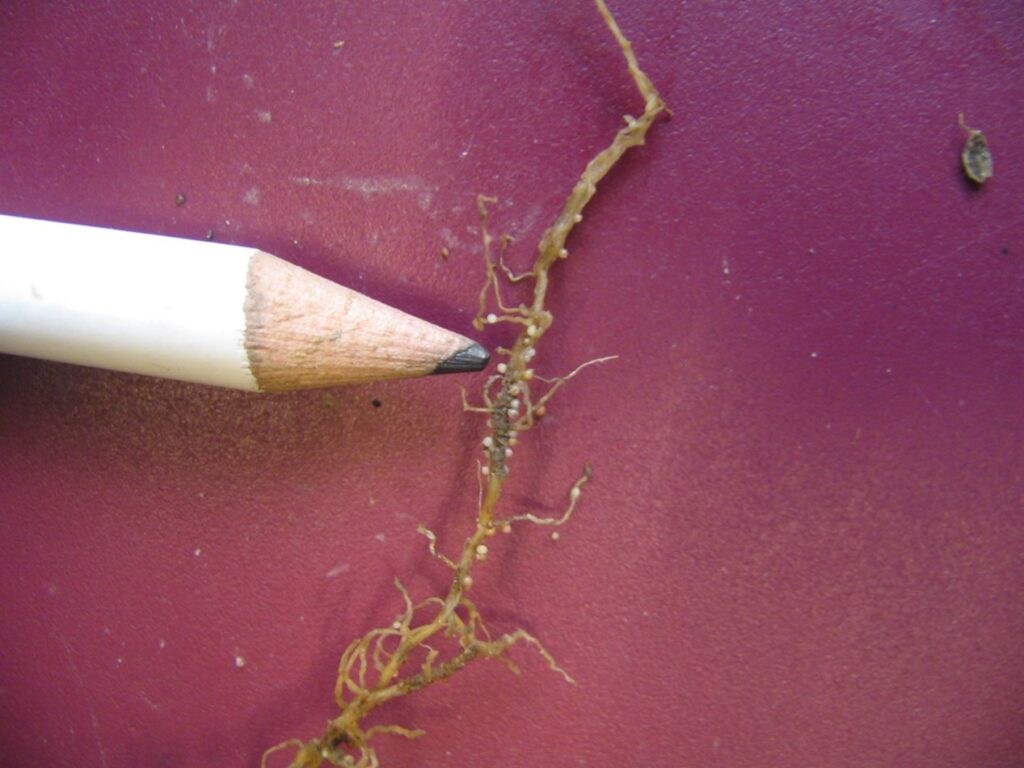Soybeans are very responsive to crop rotation. Limiting the number of soybeans in a rotation plays an important role in soybean health. It is an essential factor influencing yields, especially in a dry growing season or a year when soybean disease and pest pressure is high. Table 1, Soybean Yield Response to Tillage and Rotation, summarizes the results of long-term rotation studies conducted at the Ridgetown Campus of the University of Guelph. A rotation of soybean-winter wheat-corn, or a soybean-winter wheat rotation provided the greatest yield. On the other hand, growing soybeans continuously had the lowest yield. Yields dropped by an astonishing, 0.77 t/ha (11.4 bu/ac) when grown continuously compared to a winter wheat (red clover)-soybean-corn rotation in a conventional tillage system. Interestingly, in the no-till system yields only dropped by 0.25 t/ha (3.7 bu/ac) when comparing continuous soybeans to a winter wheat (red clover)-soybean-corn rotation. It should also be noted that a winter wheat-soybean rotation yielded much higher than a corn-soybean rotation in this study that has been established for about 30 years.
Table 1. Soybean Yield Response to Tillage and Rotation
| Average soybean yield response under long-term (established in 1995) no-till and conventional tillage systems across crop rotations on a Brookston clay loam at Ridgetown, Ontario, 2009-2014. A difference of less than 0.27 t/ha (4 bu/acre) is statistically insignificant. Source: Dave Hooker, U of G. | |||
| Crop Rotation | Tillage System | Across Tillage Systems | |
| Conventional | No-Till | ||
| Continuous soybean | 3.74 t/ha (55.6 bu/acre) | 4.06 t/ha (60.3 bu/acre) | 3.90 t/ha (58.0 bu/acre) |
| Corn-soybean | 3.87 t/ha (57.6 bu/acre) | 4.14 t/ha (61.5 bu/acre) | 4.01 t/ha (59.6 bu/acre) |
| Winter wheat-soybean | 4.35 t/ha (64.7 bu/acre) | 4.55 t/ha (67.6 bu/acre) | 4.45 t/ha (66.2 bu/acre) |
| Winter wheat (red clover)-soybean | 4.49 t/ha (66.8 t/ha) | 4.34 t/ha (64.6 bu/acre) | 4.42 t/ha (65.7 bu/acre) |
| Winter wheat-soybean-corn | 4.37 t/ha (65.0 bu/acre) | 4.42 t/ha (65.7 bu/acre) | 4.40 t/ha (65.4 bu/acre) |
| Winter wheat (red clover)-soybean-corn | 4.51 t/ha (67.0 bu/acre) | 4.31 t/ha (64.1 bu/acre) | 4.41 t/ha (65.6 bu/acre) |
| Average across crop rotation | 4.22 t/ha (62.8 bu/acre) | 4.30 t/ha (64.0 bu/acre) | |
Although not all the yield benefits associated with a good crop rotation are completely understood, a short crop rotation leads to a build-up of disease and other long-term problems which limit soybean yields. These issues include:
- Rapidly increasing soybean cyst nematode (SCN) populations. See figure 1.
- Incidence and severity of white mould, where maintaining a 3–4 year crop rotation with non-host crops will reduce the amount of white mould.
- the severity and number of races of phytophthora root rot.
- the spread of resistant weeds due to the repeated use of some herbicides.
Figure 1. Soybean Cyst Nematodes (SCN) on a soybean root.
